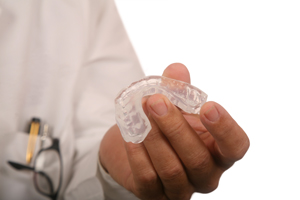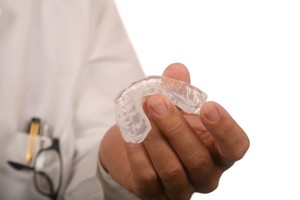
27 Jan Bruxism – Grinding and Clenching
 What is Bruxism?
What is Bruxism?
Bruxism is the technical term for grinding and clenching that wears down teeth and may cause facial pain. People who grind and clench, called bruxers, unintentionally bite down too hard at inappropriate times, such as in their sleep. In addition to grinding teeth, they also may bite their fingernails, pencils and chew the inside of their cheek. People usually aren’t diagnosed with bruxism until it is too late because so many people don’t realize they have the habit. Others mistakenly believe that their teeth must touch at all times. About one in three people suffer from bruxism, which can easily be treated by a dentist.
Can bruxism cause harm?
People who have otherwise healthy teeth and gums can clench so often and so hard that over time their teeth become sensitive. They experience jaw pain, tense muscles and headaches along with excessive wear on their teeth. Forceful biting when not eating may cause the jaw to move out of proper balance.
What are the signs?
When a person has bruxism, the tips of the teeth look flat. Teeth are worn down so much that the enamel is rubbed off, exposing the inside of the tooth which is called dentin. When exposed, dentin may become sensitive. Bruxers may experience pain in their temporomandibular joint (TMJ) -the jaw- which may manifest itself as popping and clicking. Women have a higher prevalence of bruxism possibly because they are more likely to experience tissue alterations in the jaw resulting from clenching and grinding. Tongue indentations are another sign of clenching.
Stress and certain personality types are at the root of bruxism. For as long as humankind has existed, bruxism has affected people with nervous tension. Anger, pain and frustration can trigger bruxing. People who are aggressive, competitive and hurried also may be at a greater risk for bruxism.
What can be done about it?
During regular dental visits, we automatically checks for physical signs of bruxism. The condition may be observed over several visits to be sure of the problem before recommending and starting therapy.
The objective of therapy is to change the behavior by learning how to rest the tongue, teeth and lips properly. When some people become aware of their problem, simply advising them to rest their tongue upward with teeth apart and lips shut may be enough to change their behavior and relieve discomfort. However, a plastic mouth appliance, such as a night guard that’s worn to absorb the force of biting. This appliance can prevent future damage to the teeth and helps change the patient’s destructive behavior.


